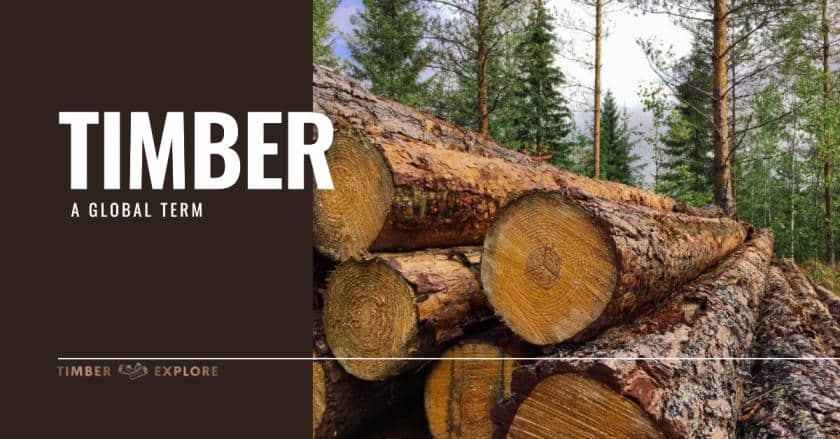In the field of construction and woodworking, two frequently encountered terms are “timber” and “lumber.” Although they both pertain to wood, they encompass distinct differences in their meanings and applications. Furthermore, their interpretation can vary based on one’s geographical location. In this article, we will unravel the global wood terminology, explain the differences between timber vs lumber, and show how geography can shape the way we talk about wood.
Timber: A Global Term

Timber is a versatile and universal term in the world of wood resources, representing the foundational material for construction & woodworking purposes. This versatile resource is obtained from the logs or rough-cut pieces of trees, often large and mature, such as oak, pine, or cedar.
Timber is a global term, often used internationally, and its characteristics and applications can vary depending on the region and the tree species from which it originates. It can be further classified into hardwood & softwood, based on the specific tree type, making it a vital raw material in the wood industry.
Geographical Variations of Timber
In the United States, the term “timber” is commonly used to describe trees that are harvested for their wood. It is essentially the wood before processing or cut into specific dimensions. When people refer to timber in the U.S, they may be talking about forests, logging, or the potential wood for harvesting.
Whereas in Australia, “timber” is also used to refer to logs or wood in its natural state. They often use this term when discussing the logging industry or when referring to wood as a building material. Moreover, it is a significant part of the construction and woodworking industries in Australia.
Lumber: The Processed Product

Lumber stands as a distinct category within the realm of timber. It represents a refined and processed form of wood that has undergone meticulous cutting, smoothing, and shaping to conform to standardized dimensions.
Lumber primarily finds its source in softwood species such as pine, fir, and spruce. Widely recognized in North America, especially in the United States and Canada, the term “lumber” signifies timber transformed into a precise and quality-assured material, catering to various construction & woodworking needs.
Geographical Variations of Lumber
In North America, particularly in the United States and Canada, “lumber” is the preferred term for wood that is cut and processed for construction and woodworking purposes. It is available in standardized sizes, making it easy to use for various building projects. For instance, you’ll often hear terms like “2x4s” and “2x6s” in reference to standard lumber sizes used in framing & construction.
Key Differences
| Factor | Timber | Lumber |
|---|---|---|
| Source | Raw wood from trees | Processed wood, ready for use |
| Usage | General term for wood in its natural state | Specifically processed for construction |
| Standardization | No standardized dimensions | Available in standardized sizes |
| Terminology | Used internationally with variations | Primarily used in North America |
| Applications | Varied uses depending on local practices | Construction, framing, woodworking |
Applications
The choice between timber & lumber largely depends on the specific requirements of your project and the availability of wood species in your region. Here is a complete breakdown of their typical applications:
Timber Applications:
- Heavy Construction: It is ideal for structural components in large construction projects such as bridges, skyscrapers, and industrial facilities.
- Fine Woodworking: Its natural beauty makes it a preferred choice for crafting high-end furniture, cabinetry, and intricate woodwork.
- Architectural Features: It is widely used to create decorative and architectural elements like exposed beams and trusses.
- Longevity: Timber is chosen when durability and longevity are essential, especially in outdoor applications.
Lumber Applications:
- Framing: Lumber is widely used for framing houses, sheds, and other buildings due to its affordability & versatility.
- Sheathing: It serves as sheathing material to provide structural support and insulation for walls and roofs.
- DIY Projects: It is a go-to choice for DIY enthusiasts, as its standardized dimensions make it easy to work with for various projects like shelves, decks, and fences.
- Temporary Structures: Lumber is suitable for temporary structures like scaffolding and formwork due to its cost-effectiveness.
Timber vs Lumber : The Conclusion
In conclusion, the timber vs. lumber debate underline the importance of considering regional variations and local customs in the terminology of wood. While “timber” often signifies wood in its natural state, “lumber” designates processed wood suitable for construction or woodworking.
Whether you find yourself immersed in the vast forests of timber-rich regions, the bustling construction sites of lumber-driven economies, or the artisanal wood shops of woodworking enthusiasts, understanding these distinctions in terminology ensures effective communication in the diverse world of woodworking. So, the next time you engage in a conversation about wood, you’ll be well equipped to use the right terms—whether “timber” or “lumber”—tailored to your location and audience’s expectations.
Furthermore, Timber Explore opens the door to a wide range of information about timber & lumber. By delving into various types and uses of these wood resources, you can unlock a wealth of knowledge essential for woodworking and construction. For more in-depth information and their wide-ranging applications, we cordially invite you to continue your exploration at Timber Explore. Happy Woodworking!

